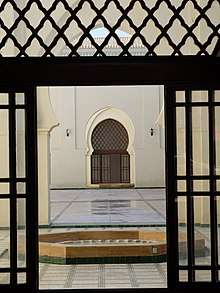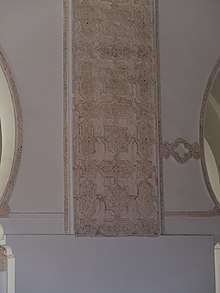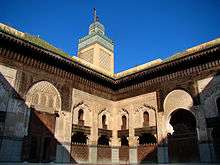Kasbah Mosque (Marrakech)
| Kasbah Mosque | |
|---|---|
|
| |
| Basic information | |
| Location | Marrakesh, Morocco |
| Affiliation | Sunni Islam |
| District | Marrakesh |
| Region | Morocco |
| Ecclesiastical or organizational status | In use |
| Status | Active |
| Architectural description | |
| Architectural type | Mosque |
| Architectural style | Almohad |
| Groundbreaking | 1185 |
| Completed | 1189-1190 |
| Specifications | |
| Minaret(s) | 1 |
| Materials | Brick, rubble stone, wood |
The Kasbah Mosque (also: Mansouria Mosque or Mosque of Moulay al-Yazid[1]) of Marrakech is a Friday Mosque originally built by the Almohad caliph Yaqub al-Mansour in 1185-1190 CE. It is located in the old kasbah of Marrakech, the citadel or royal district. Along with the Koutoubia Mosque, it is one of the most important historical mosques in Marrakech.[2]
History
Construction of the mosque was probably begun around 1185 and finished by 1190 (CE).[2][3] It was commissioned by the Almohad Caliph Yaqub al-Mansour (ruled 1184–1199), at the apogee of the Almohad Empire, along with the rest of the new imperial kasbah (citadel) district which was to be the residence of the Almohad Caliph and the seat of government.[2] This followed with a long tradition of rulers in the Islamic world (and beyond) who built palace-cities or separate royal districts. The Kasbah Mosque was built to be the Friday Mosque (or Grand Mosque) for the caliph and for the royal district, where the ruler would go for prayer.
Even after al-Mansour and after the Almohad Empire had gone, the Kasbah Mosque was held in high esteem by the general population and subsequent rulers, and even competed with the Koutoubia Mosque for prestige.[2] As early as the Marinid era, rulers and important figures began to be buried in a cemetery just to the south of the mosque, eventually becoming the site of the Saadi dynasty's royal necropolis (referred to as the Saadian Tombs today).[3]
In the late 16th century the mosque was severely damaged by an enormous explosion at a nearby gunpowder store. The exact date of the event is not certain, with the earliest estimation being 1562 while the latest it could have happened was in 1573-1574.[3] In any case, the Saadi sultan Moulay Abd Allah al-Ghalib (ruled 1557-1574) undertook extensive repairs and restorations in the wake of the explosion, with the southern part of the mosque having possibly been the most damaged.[3] The repairs and reconstruction are believed to have closely preserved the original Almohad layout, although the stucco decoration visible inside the mosque today is most likely entirely Saadian and replaced whatever decoration would have existed earlier.[3] Even after these repairs, long cracks in the minaret remained visible up until the 20th century.[3]
Later, the Alaouite sultan Sidi Muhammad Ibn Abd Allah (ruled 1757-1790) undertook another round of extensive restorations during the second half of the 18th century.[2] The wooden cupola at the central entrance to the prayer hall coming from the courtyard dates from this time, as may other elements.[3] Despite this, it still appears that these later sultans faithfully preserved the form of the original mosque, which may be an indication of the esteem in which it was held.[4][3]
Today, the mosque is still in use for prayer and non-Muslims are not permitted to enter inside (as with other mosques in Morocco).[5]
Description

Exterior
Outer walls and facades
The exterior of the mosque is imposing, with high walls crowned along the top by merlons above a row of corbels. Along the walls are large pointed horseshoe arches, most of which are blind (i.e. walled-in) while some frame the gates of the mosque. Some of these arches on the southwestern side of the mosque accommodate space for shops.
The minaret
The minaret, like the more famous Koutoubia minaret and other minarets in the Maghreb, has a square base (8.8 meters per side) and is divided vertically into two parts: a main body and a much smaller lantern (almost 4 meters per side) at the top.[2] The decoration of this minaret is different from that of the Koutoubia however, and would go on to become the prototype for many later minarets built in the Maghreb and al-Andalus.[2][3]

The main part of the minaret has plain walls made of rubble stone up to the level of the mosque's roof, at which point the rest of the minaret is made of brick and the decoration begins. From here, on each of the almost identical four sides, three thin horseshoe arches are flanked by engaged columns that lead to larger polylobed arches, flanked in turn by very short engaged columns. The engaged columns were once covered in coloured faience (ceramic material).[2] These elements then blend into the much larger decorative facades above them. These facades features a wide interlacing sebka pattern (a common maghrebi motif that variably resembles palmettes or fleur-de-lys) sculpted in brick and filled-in with green faience.[3] Towards the top, a large frieze of green and white geometric mosaic tiles wraps around the minaret, before finishing in a crown of merlons. Between the mosaic tile frieze and the merlons there is an empty horizontal band that used to be filled by an Arabic inscription in cuerda seca tiles, with dark (maybe purple) lettering on a white background.[2][3] This inscription was in prominent kufic script and featured the first surah of the Qur'an, Al-Fatiha. This frieze did not survive but fragments of it have been found, while the rest of the tile mosaics on the minaret needed to be restored in recent times.[6]
Above this main part of the minaret, the short lantern on top makes use of similar decoration. It is surmounted by three copper spheres. A once widely-reported belief alleged that they were actually made of pure gold; a legend which originated with this mosque but was latter attributed to the Koutoubia minaret.[2]
Although the decoration of the four sides of the minaret is almost the same, there are subtle differences between the north and south facades on the one hand and the east and west facades on the other, with details of the shapes of the sebka pattern and of the polylobed arches on the lower facade varying slightly.[2]

Interior
Courtyards and overall layout
The mosque is roughly square in plan (but not quite).[4] The layout of the mosque is notable for being dominated by the size of its courtyard and for the division of the courtyard into five parts: a very large central rectangular courtyard and four smaller auxiliary courtyards at its corners. The four smaller courtyards are placed in two symmetrical pairs around the main courtyard: two on the west side, two on the east, and separated from the main courtyard simply by an arcade of arches. The large roofless space of the courtyards is surrounded by the indoor prayer hall on one side (to the south) and by a roofed gallery running along the other sides. The space between each pair of auxiliary courtyards (i.e. on the west and on the east sides) is taken up by a narrow roofed aisle as well - essentially projections of the surrounding gallery. The main courtyard features two fountains: a central one and a larger one closer to the northern entrance. The two smaller courtyards that are closest to the prayer hall each feature their own central fountain as well.[2] As in other mosques, these fountains serve for ablutions before prayer.
The prayer hall itself is located on the south side of the courtyard, and is a hypostyle space with rows of arches three aisles deep, with the last aisle along the qibla wall (furthest from the courtyard) marked off by an extra transverse row of arches (parallel to the qibla wall).
This floor plan is unusual compared to the classical layout of mosques in the western Islamic world (i.e. in the Maghreb and al-Andalus) which usually consists of one large courtyard and a generally larger adjacent prayer hall (like at the influential Great Mosque of Cordoba and the prototypical Almohad mosque at Tin Mal, for example).[7] Nonetheless, the mosque still shares many similarities to other Almohad or medieval mosques in the region, as its construction was more or less contemporary with the Koutoubia Mosque in Marrakech, the Hassan Tower in Rabat, and the Almohad Mosque of Seville (replaced by a cathedral but preserving elements like its minaret, the Giralda). For example, even though the proportions of the prayer hall are much reduced, the central aisle that leads from the courtyard to the mihrab in the qibla wall and the aisle that runs along the qibla wall are emphasized architecturally in their width and decoration, a standard feature of classic Moroccan and Andalusian mosques sometimes referred to as a "T-plan" or "T-type" (because the two aisles together form a "T" shape on the floor plan).[7][2]

Decoration of the interior
Like most Almohad mosques, the mosque is relatively austere and much of its aesthetic effect inside is achieved by the rhythmic repetition of arches in the courtyard and prayer hall.[7][3] The arches themselves vary slightly in shape and look. Most are horseshoe arches, with many of them embellished simply by carved outlines of pointed or polylobed arches around them. Some of the arches (around the mihrab, for example), are more elaborate polylobed and "lambrequin" (muqarnas-shaped) arches, all commonly found in Moorish architecture. Some of the pillars of the arches also feature small engaged columns with ornate capitals from the Almohad and Saadian periods.[3] Additionally, in the outer aisles of the mosque (including the galleries around the courtyard) the wall-space between and above the arches is marked by bands and lines of stucco carved with geometric and arabesque patterns, very similar to those found in the Mouassine Mosque and Bab Doukkala Mosque from the Saadian period.[3]
The mihrab and surrounding area
The most decorated area is that around the mihrab, a niche in the qibla wall symbolizing the direction of prayer. This section, which was rebuilt/restored in the late 16th century (Saadian period), likely still preserves the model and layout from the Almohad era and resembles the mihrab of important Almohad mosques like the one at Tin Mal. However, the stucco decoration that covers the wall around the mihrab is very similar to the decoration of mirhabs of Saadian buildings like the Ben Youssef Madrasa and the Bab Doukkala Mosque, and thus likely dates from the Saadian restoration.[3] This decoration features elaborate arabesques in high-relief, with pinecones and seashells featuring among the decorative repertoire. A prominent inscription in kufic Arabic features the basmala and a passage from the Qur'anic surah An-Nur.[3] Below the level of the stucco decoration, twelve engaged columns of jasper and marble with Umayyad-style capitals are incorporated into the mihrab area.[3]
On either side of the mihrab are two doors giving access to small chambers, one of which was used to store the wooden minbar (a ceremonial pulpit). Much like the minbar at the Koutoubia Mosque, the minbar of the Kasbah Mosque originally moved forward and emerged from the doors with the help of an unknown mechanism that made it appear to move forward on its own. This mechanism was gone, or no longer functional, by the end of the 16th century.[2] The minbar itself, which has suffered over time but still exists today, is smaller but very similar in style to the famous Almoravid minbar of the Koutoubia Mosque which was crafted earlier that century in Cordoba. It was quite likely made by Andalucian craftsman too or by Moroccan craftsmen following in the same tradition, and was commissioned by Yaqub al-Mansour, who likely wished to emulate the earlier Almoravid minbar.[2][8]
Above and right in front of the mihrab is a large square cupola filled with a dome of finely-carved and painted muqarnas, while similar cupolas stand above either end of the qibla aisle (that is, at the southwestern and southeastern corners of the building). Inside the mihrab niche itself is also another small muqarnas cupola.[3] The wooden ceilings elsewhere in the mosque are in an artesonado style typical of Moroccan and Moorish architecture. These cupolas and ceilings almost certainly all date from post-Almohad restorations.[3][2]

Qibla and orientation of the mosque
The mosque, like other Almohad and medieval mosques in the western Islamic world, is technically not correctly oriented towards the true qibla (i.e. the direction of Mecca). Its qibla is oriented too far to the south and would require a counter-clockwise rotation of 89 degrees towards the east in order to match the standard qibla orientation used in modern mosques.[4] This is due to historical debates about the direction of the qibla in far western Islamic lands like Morocco and Spain; as a result, the qibla orientation of Marrakech's mosques varies depending on the historical period in which they were built.[9]
Surrounding area
The mosque is in the old kasbah district of Marrakech and is thus located not far from the El-Badi Palace and from the current Royal Palace still used by the Moroccan king today. Most notably, on the southern side of the mosque are located the Saadian Tombs, a narrow necropolis with ornate mausoleums that housed the tombs of the Saadi Dynasty and now a major tourist attraction in Marrakech.[5] The mosque is also very close to the city walls and to Bab Agnaou, one of the most notable gates in Marrakech.
References
| Wikimedia Commons has media related to Kasbah Mosque, Marrakech. |
- ↑ Hamouda. "La mosquée Moulay Al Yazid (les Almohades)" (in French). Retrieved 2018-01-11.
- 1 2 3 4 5 6 7 8 9 10 11 12 13 14 15 16 Deverdun, Gaston (1959). Marrakech: Des origines à 1912. Rabat: Éditions Techniques Nord-Africaines.
- 1 2 3 4 5 6 7 8 9 10 11 12 13 14 15 16 17 18 19 Salmon, Xavier (2016). Marrakech: Splendeurs saadiennes: 1550-1650. Paris: LienArt. p. 82. ISBN 9782359061826.
- 1 2 3 "Masjid Mawlay al-Yazid | Archnet". archnet.org. Retrieved 2018-01-11.
- 1 2 Lonely Planet: Morocco (12th edition). Lonely Planet. 2017. ISBN 9781786570321.
- ↑ Lintz, Yannick; Déléry, Claire; Tuil Leonetti, Bulle (2014). Le Maroc médiéval: Un empire de l'Afrique à l'Espagne. Paris: Louvre éditions. p. 331. ISBN 9782350314907.
- 1 2 3 Ewert, Christian (1992). "The Architectural Heritage of Islamic Spain in North Africa". In Dodds, Jerrilynn D. Al-Andalus: The Art of Islamic Spain. New York: The Metropolitan Museum of Art. pp. 85–95. ISBN 0870996371.
- ↑ Carboni, Stefano (1998). "Signification historique et artistique du minbar de la mosquée Kutubiyya". Le Minbar de la Mosquée Kutubiyya. New York: The Metropolitan Museum of Art. pp. 41–65. ISBN 8486022967.
- ↑ Wilbaux, Quentin (2001). La médina de Marrakech: Formation des espaces urbains d'une ancienne capitale du Maroc. Paris: L'Harmattan. ISBN 2747523888.

